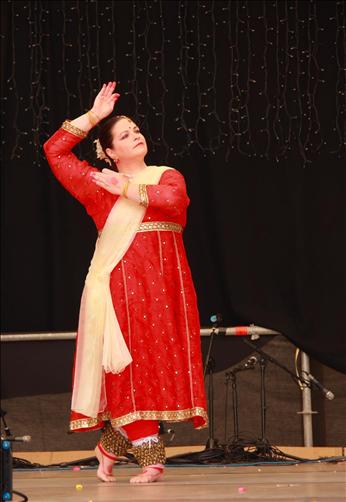 For the past several years, I have been involved in various Auckland Diwali festivals performing traditional Kathak dances.
For the past several years, I have been involved in various Auckland Diwali festivals performing traditional Kathak dances.
At these festivals, we see all the propaganda such as photos of beautifully arranged diyas, large posters of Goddess of Wealth Mahalakshmi, fireworks displays, people wearing new clothes, exchanging gifts and sweets, and making intricate rangoli designs.
But as with everything in Hinduism, all of these symbols represent deeper spiritual aspects. Nearly everyone has some basic level of awareness of these deeper meanings, as they are often written about in newspapers during the occasion, but how many incorporate these deeper aspects?
Most people are concerned with an outward aesthetic display, spending a great deal of time and money cleaning their houses, purchasing the beautiful diyas and hosting big Diwali celebrations. They may even have special pujas in their homes.
These celebrations make us feel happy; however, do they represent the true meaning of Diwali?
When these people return to work the next day, we see that they have forgotten to clean out the cobwebs of their mind and rid their hearts of ill intentions towards others.
Divine intones
If we remember the symbolism of this Festival of Lights (that is written about in so many publications during this time), then we know that it represents the inner light that is present in us all.
We also know that lit lamps symbolise the driving away of darkness (Ignorance) to allow knowledge to be present.
While the articles are well meaning, they lack the link between this physical lamp and the actual process of removing the darkness.
But what about an even deeper meaning? After all, how can one expect the light of a diya to cleanse the cobwebs of the heart?
According to the Advayataraka Upanishad, the power to disperse the darkness can only be given by the Guru (Gu meaning shadows and ru meaning the one who disperses them).
Thus, the material displays of light cannot remove the darkness that is so often referred to in articles about Diwali symbolism. Rather, the Guru or the spiritual guide is the only one who can remove this darkness and bring the light.
This “light” being referred to is spiritual awakening that can manifest only when we have gone through intense purifications of our minds and bodies.
This purified person eventually, through austere practices, becomes one with the Supreme Spirit and a channel of Divine Knowledge for others.
Purification Process
The process of becoming purified is a complex process – too complex to detail in this short article, but involves gradually raising our centre of consciousness.
This cannot be done unless we understand through the Guru’s healing how to purify ourselves. However, our ego and minds are the main cause of our impurity.
“We forget that the welfare of our fellow human beings, animals, and nature are inseparable from our own. We become egocentric, selfish and mean-spirited towards others.” (Meditation and Spiritual Life by Swami Yatiswarananda).
We must always be honest with ourselves.
It is not always so obvious as going out and committing murder; it can be as subtle as secretly wishing for someone to fail at something or subtly arranging situations so that others are at a disadvantage or are prevented from progressing.
The other aspect of purification is taking care of the body.
The body “is neither an instrument for sense gratification, nor a mass of filth to be hated and neglected. The body is primarily a temple of the divine Spirit and must be kept clean and strong.” (Ibid).
So this Diwali, as you are cleaning your house and preparing for the external celebrations, reflect on the true meaning of the light and begin the process of truly cleaning the body and the mind of ignorance and making a place in your heart for the lessons of the countless rishis, sages, and gurus to dwell.
We must be as thorough with ourselves as we are with our homes.
Suzett Perry is a Regulatory Affairs Team Leader at a major pharmaceutical company based in Auckland. An initiate of Tap Energy and Reiki Healing, she has learned Kathak from masters in India and is currently enrolled in a Bharata Natyam programme of dance master Kalaichelvi Uthayakumaran (Narthana Aalayam) in Auckland, in association with Annamalai University in Chennai.






